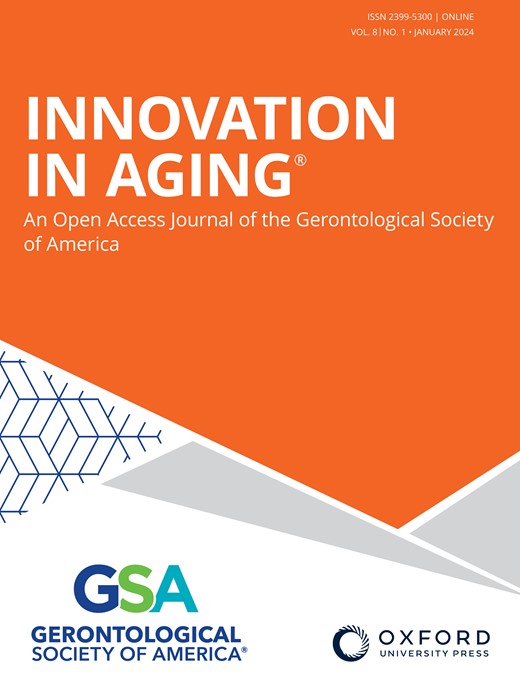SKELETAL MUSCLE ENERGETICS ARE ASSOCIATED WITH PERFORMANCE FATIGABILITY
IF 4.9
3区 医学
Q1 GERIATRICS & GERONTOLOGY
引用次数: 0
Abstract
Abstract Performance fatigability manifests as insufficient energy to complete daily physical tasks and worsens with aging, exacerbating vulnerability to disability. Skeletal muscle energetics also declines with aging. Thus, we hypothesized muscle energetics may be an important contributor to performance fatigability. In the Study of Muscle, Mobility and Aging (SOMMA), participants completed a usual-paced 400m walk while wearing a wrist-worn ActiGraph, from which raw data were used to derive the Pittsburgh Performance Fatigability Index (PPFI, higher=more severe fatigability) that quantifies percent decline in the entire individual cadence-versus-time trajectory. Maximal oxidative phosphorylation (maxOXPHOS) in skeletal muscle mitochondria was quantified in vitro using high-resolution respirometry in permeabilized fiber bundles from vastus lateralis muscle biopsies. Maximal adenosine triphosphate production (ATPmax) was assessed in vivo by 31P magnetic resonance spectroscopy. We conducted separate tobit regressions to examine associations of maxOXPHOS and ATPmax with PPFI, adjusting for technician/site, age, sex, race, height, weight, and mins/day moderate-to-vigorous physical activity measured by ActiGraph in free-living, in N=795 participants with complete PPFI scores and >1 energetics measure (70-94 yrs, 58% women). Median PPFI scores were 1.4% [IQR: 0-2.9%]. After adjustment, each SD (18.4 pmol/(s*mg)) lower maxOXPHOS was associated with 0.55% (95% CI: 0.26, 0.85) higher PPFI scores, while each SD (0.2 mM/sec) lower ATPmax was associated with 0.54% (95% CI: 0.27, 0.81) higher PPFI scores. Our results indicate that lower skeletal muscle energetics were associated with more severe performance fatigability. This suggests that therapeutics targeting muscle energetics may thereby potentially mitigate fatigability and lessen susceptibility to disability among older adults.骨骼肌能量与运动疲劳相关
摘要 运动疲劳表现为完成日常体力任务时能量不足,并随着年龄的增长而加剧,使人更容易致残。骨骼肌的能量也会随着年龄的增长而下降。因此,我们假设肌肉能量可能是导致表现疲劳的一个重要因素。在 "肌肉、活动能力与衰老研究"(SOMMA)中,参与者佩戴腕戴式 ActiGraph 完成了正常步速的 400 米步行,根据原始数据得出匹兹堡运动表现疲劳指数(PPFI,越高疲劳越严重),该指数量化了整个个人步速-时间轨迹的下降百分比。骨骼肌线粒体的最大氧化磷酸化(maxOXPHOS)是在体外使用高分辨率呼吸测定法对侧阔肌活检组织中的通透纤维束进行量化的。三磷酸腺苷的最大产生量(ATPmax)是通过 31P 磁共振波谱在体内进行评估的。我们对 795 名具有完整 PPFI 分数和 1 项以上能量测量指标的参与者(70-94 岁,58% 为女性)进行了单独的托比特回归,以研究最大氧活量和 ATPmax 与 PPFI 的关系,并调整了技术人员/地点、年龄、性别、种族、身高、体重以及由 ActiGraph 在自由生活状态下测量的分钟/天中度到剧烈运动。PPFI 分数的中位数为 1.4% [IQR:0-2.9%]。经过调整后,最大氧合机每降低一个 SD 值(18.4 pmol/(s*mg)),PPFI 分数就会提高 0.55% (95% CI: 0.26, 0.85),而 ATPmax 每降低一个 SD 值(0.2 mM/sec),PPFI 分数就会提高 0.54% (95% CI: 0.27, 0.81)。我们的研究结果表明,骨骼肌能量较低与更严重的运动疲劳有关。这表明,针对肌肉能量的治疗方法可能会减轻老年人的疲劳感,并降低其对残疾的易感性。
本文章由计算机程序翻译,如有差异,请以英文原文为准。
求助全文
约1分钟内获得全文
求助全文
来源期刊

Innovation in Aging
GERIATRICS & GERONTOLOGY-
CiteScore
4.10
自引率
0.00%
发文量
72
审稿时长
15 weeks
期刊介绍:
Innovation in Aging, an interdisciplinary Open Access journal of the Gerontological Society of America (GSA), is dedicated to publishing innovative, conceptually robust, and methodologically rigorous research focused on aging and the life course. The journal aims to present studies with the potential to significantly enhance the health, functionality, and overall well-being of older adults by translating scientific insights into practical applications. Research published in the journal spans a variety of settings, including community, clinical, and laboratory contexts, with a clear emphasis on issues that are directly pertinent to aging and the dynamics of life over time. The content of the journal mirrors the diverse research interests of GSA members and encompasses a range of study types. These include the validation of new conceptual or theoretical models, assessments of factors impacting the health and well-being of older adults, evaluations of interventions and policies, the implementation of groundbreaking research methodologies, interdisciplinary research that adapts concepts and methods from other fields to aging studies, and the use of modeling and simulations to understand factors and processes influencing aging outcomes. The journal welcomes contributions from scholars across various disciplines, such as technology, engineering, architecture, economics, business, law, political science, public policy, education, public health, social and psychological sciences, biomedical and health sciences, and the humanities and arts, reflecting a holistic approach to advancing knowledge in gerontology.
 求助内容:
求助内容: 应助结果提醒方式:
应助结果提醒方式:


